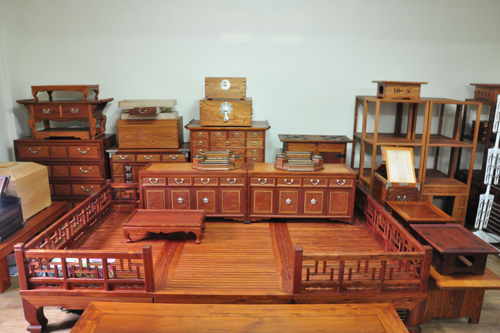중요무형문화재 제 91호 설석철 소목장
Infinite challenge to make Korea Wooden Furniture worldwide
By Kim Hyun kyung, Tribune Reporter
Most people would probably think that the word ‘Somokjang’ means a farm that raises cows. However, it refers to the people who make small wooden furniture or stationery, and ‘Damokjang’ makes palaces, Buddhist temples and structures for making houses. The furniture of Somokjang reflects Korea’s peculiar molding style and it contributes to the increase in value of folk handicraft. The Somokjang is designated as Korea’s Important Intangible Cultural Property No.55.

The Chonnam Tribune visited Somokjang Seol Suk-cheolwho lives in Jang-seong. He was chosen as a somokjang ability holder in 2001. Now, he is 88 so he cannot actually work as a somokjang anymore. Instead of him, his three sons are learning from him to continue on the tradition of their father’s skills. Master Seol lost one of his eyes while cutting a Zelkova tree. Although he cannot see well and had injured legs, he lives as a somokjang with passion.
Master Seol made this reporter disconcerted the moment we asked him the first question. “Why did you start this job?” His answer was ‘to live’. At that time, living circumstances were not good so he had to work. It was easy to learn for him because his father did the same kind of work. Then, it was designated as an important intangible cultural asset. Doing his work for a long time, he naturally became a craftsman who was following the tradition. Actually, he was not too excited when somokjang was designated as an asset because it was just his job for ages. But he was extremely pleased when he became a myungjang. He went to Seoul to compete with others to be a myungjang and won the first place out of six or seven somokjangs and finally he got the title of myungjang. He said that moment was the best in his life.

Master Seol is not free to move around everywhere, so instead, his son Seol Yeun-woon guided us through the workshop. In the workshop, there were several kinds of old wood machines. He showed us the process of modifying wood quite freely using the tools such as a plane chisel. It was amazing to see how wood can be reshaped so easily. Next, we entered the room filled with products. As soon as we entered the room, I could smell the woods and see jang (multilevel chests), nong (multiunit stacked chests) and bandaji (waist-high chests with a hinged front flap). He said that it is so precious that he cannot sell the products so he is keeping them with loving care.
A small number of people visiting Seol Suk-cheol’s house come to learn the skills, but they could not endure for long and leave the workshop. Living as a somokjang does not provide a high compensation and the government’s support fund is too low. In modern times, people are focused on making money rather than following tradition. Fortunately, Seol Suk-cheol’s three sons are going to step into their father’s shoes. Koreans think that somokjang is an unfamiliar term, so the father-son desire to give wider publicity has increased. From looking for fine wood and making furniture with sincerity, it is a job preserved by tradition. Our contemporaries do not even know the meaning of somokjang clearly. It would be better for us to buy Korean traditional wooden furniture so that our tradition can be carried on.
김현경 기자
iloveseunggi@nate.com

